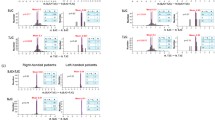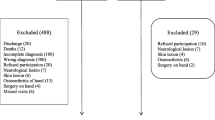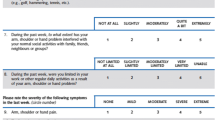Abstract
Rheumatoid arthritis occurs two to three times more often in women than in men and it has been less studied in men. The results of gender influence on clinical course of the disease are contradictory. The aim of this study is to determine the difference in handgrip strength between female and male RA patients in comparison to healthy individuals. The study included 100 RA patients and 100 healthy individuals (50% were male in both groups). Handgrip strength was measured in both hands using a dynamometer. A two-way ANCOVA was used to analyse the data and age was included in the study as covariate. The results show that both male and female RA patients have lower handgrip strength compared to healthy individuals. The analysis of gender and disease interaction has shown that male RA patients have lower handgrip strength than female RA patients in comparison with the healthy group, age adjusted. This interaction is evident and statistically significant in both right hand (F 1, 195) = 14.62; p < 0.01) and left hand (F 1, 195) = 20.54; p < 0.01). The common-language effect size has shown that there is 92% (right hand) and 93% (left hand) chance that male individual will have stronger handgrip than his female counterpart. In RA patients, there is 77% chance for both hands that male will have stronger handgrip. Men and women with RA have significantly lower handgrip strength compared to healthy individuals and the difference is more pronounced in men which was not previously observed in the literature.


Similar content being viewed by others
Data availability
Dataset is available in the supplement materials.
Code availability
Code is available in the supplement materials.
References
Sheehy C, Gaffney K, Mukhtyar C (2013) Standardized grip strength as an outcome measure in early rheumatoid arthritis. Scand J Rheumatol 42:289–293. https://doi.org/10.3109/03009742.2012.747624
Erol AM, Ceceli E, Uysal Ramadan S, Borman P (2016) Effect of rheumatoid arthritis on strength, dexterity, coordination and functional status of the hand: the relationship with magnetic resonance imaging findings. Acta Reumatol Port 41:328–337
Kennedy D, Jerosch-Herold C, Hickson M (2010) The reliability of one vs. three trials of pain-free grip strength in subjects with rheumatoid arthritis. J Hand Ther 23:384–391. https://doi.org/10.1016/j.jht.2010.05.002
Sferra da Silva G, de Almeida LM, de Assis MR (2018) Hand strength in patients with RA correlates strongly with function but not with activity of disease. Adv Rheumatol 58:20. https://doi.org/10.1186/s42358-018-0020-1
Dedeoğlu M, Gafuroğlu Ü, Yilmaz Ö, Bodur H (2013) The relationship between hand grip and pinch strengths and disease activity, articular damage, pain, and disability in patients with rheumatoid arthritis. Arch Rheumatol 28:069–077. https://doi.org/10.5606/tjr.2013.2742
Sui SX, Holloway-Kew KL, Hyde NK et al (2020) Handgrip strength and muscle quality in Australian women: cross-sectional data from the Geelong Osteoporosis Study. J Cachexia Sarcopenia Muscle 11:690–697. https://doi.org/10.1002/jcsm.12544
Bodur H, Yılmaz Ö, Keskin D (2006) Hand disability and related variables in patients with rheumatoid arthritis. Rheumatol Int 26:541–544. https://doi.org/10.1007/s00296-005-0023-1
Higgins SC, Adams J, Hughes R (2018) Measuring hand grip strength in rheumatoid arthritis. Rheumatol Int 38:707–714. https://doi.org/10.1007/s00296-018-4024-2
Eberhardt K, Sandqvist G, Geborek P (2008) Hand function tests are important and sensitive tools for assessment of treatment response in patients with rheumatoid arthritis. Scand J Rheumatol 37:109–112. https://doi.org/10.1080/03009740701747129
Herrera-Sandate P, Vega-Morales D, De-Leon-Ibarra AL et al (2021) POS1446 anthropometric measurements in upper extremity rehabilitation of patients with rheumatic diseases. Ann Rheum Dis 80:1007–1007. https://doi.org/10.1136/annrheumdis-2021-eular.1301
van Vollenhoven RF (2009) Sex differences in rheumatoid arthritis: more than meets the eye. BMC Med 7:12. https://doi.org/10.1186/1741-7015-7-12
Sokka T, Toloza S, Cutolo M et al (2009) Women, men, and rheumatoid arthritis: analyses of disease activity, disease characteristics, and treatments in the QUEST-RA Study. Arthritis Res Ther 11:R7. https://doi.org/10.1186/ar2591
Beenakker KGM, Ling CH, Meskers CGM et al (2010) Patterns of muscle strength loss with age in the general population and patients with a chronic inflammatory state. Ageing Res Rev 9:431–436. https://doi.org/10.1016/j.arr.2010.05.005
Björk MA, Thyberg ISM, Skogh T, Gerdle BUC (2007) Hand function and activity limitation according to health assessment questionnaire in patients with rheumatoid arthritis and healthy referents: 5-year followup of predictors of activity limitation (The Swedish TIRA Project). J Rheumatol 34:296–302
Wiśniowska-Szurlej A, Ćwirlej-Sozańska A, Kilian J et al (2021) Reference values and factors associated with hand grip strength among older adults living in southeastern Poland. Sci Rep 11:9950. https://doi.org/10.1038/s41598-021-89408-9
Aletaha D, Neogi T, Silman AJ et al (2010) 2010 Rheumatoid arthritis classification criteria: an American College of Rheumatology/European League Against Rheumatism collaborative initiative. Arthritis Rheum 62:2569–2581. https://doi.org/10.1002/art.27584
Uçkun AÇ, Güveni̇r AA, Yurdakul FG et al (2019) Hand grip strength in elderly rheumatoid arthritis patients. Duzce Med J 21:210–213
Nordenskiöld UM, Grimby G (1993) Grip force in patients with rheumatoid arthritis and fibromyalgia and in healthy subjects. a study with the Grippit instrument. Scand J Rheumatol 22:14–19. https://doi.org/10.3109/03009749309095105
Spector TD, Perry LA, Tubb G et al (1988) Low free testosterone levels in rheumatoid arthritis. Ann Rheum Dis 47:65–68. https://doi.org/10.1136/ard.47.1.65
Rkain H, Allali F, Jroundi I, Hajjaj-Hassouni N (2006) Socioeconomic impact of rheumatoid arthritis in Morocco. Joint Bone Spine 73:278–283. https://doi.org/10.1016/j.jbspin.2005.03.021
Bartley EJ, Fillingim RB (2013) Sex differences in pain: a brief review of clinical and experimental findings. Br J Anaesth 111:52–58. https://doi.org/10.1093/bja/aet127
Kvien TK, Uhlig T, Ødegård S, Heiberg MS (2006) Epidemiological aspects of rheumatoid arthritis: the sex ratio. Ann N Y Acad Sci 1069:212–222. https://doi.org/10.1196/annals.1351.019
Lee J, Lee M-G (2019) Associations of handgrip strength with prevalence of rheumatoid arthritis and diabetes mellitus in older adults. J Obes Metab Syndr 28:271–277. https://doi.org/10.7570/jomes.2019.28.4.271
Funding
The authors received no specific funding for this work.
Author information
Authors and Affiliations
Contributions
All authors (NŽ, MV, IJ, PP, JB, AM, HKM, NLŽ, KKD, NK, IŽ and ILC) contributed to the conception and initial design of the project. Material preparation and data acquisition were performed by JB. Statistical analysis of the data was performed by IJ. All authors (NŽ, MV, IJ, PP, JB, AM, HKM, NLŽ, KKD, NK, IŽ and ILC) contributed to the interpretation of the data. The first draft was written by JB and revised by MV. All authors (NŽ, MV, IJ, PP, JB, AM, HKM, NLŽ, KKD, NK, IŽ and ILC) reviewed the manuscript prior to submission. All authors (NŽ, MV, IJ, PP, JB, AM, HKM, NLŽ, KKD, NK, IŽ and ILC) approved final version.
Corresponding author
Ethics declarations
Conflict of interest
All authors declare that they have no conflict of interest.
Ethical approval
This is an observational study. The Clinical Hospital Centre Zagreb Research Ethics Committee has confirmed that no ethical approval is required. All the procedures being performed were part of the routine measurements prior to physical therapy.
Consent to participate
Verbal informed consent was obtained from all participants prior to testing.
Consent to publish
The participants have consented to the submission to the journal.
Additional information
Publisher's Note
Springer Nature remains neutral with regard to jurisdictional claims in published maps and institutional affiliations.
Supplementary Information
Below is the link to the electronic supplementary material.
Rights and permissions
About this article
Cite this article
Žura, N., Vukorepa, M., Jurak, I. et al. Decrease in handgrip strength in rheumatoid arthritis (RA): is there a sex-related difference?. Rheumatol Int 41, 1795–1802 (2021). https://doi.org/10.1007/s00296-021-04959-4
Received:
Accepted:
Published:
Issue Date:
DOI: https://doi.org/10.1007/s00296-021-04959-4




